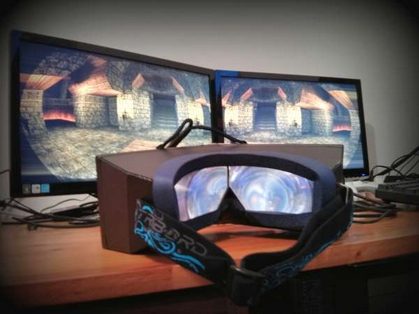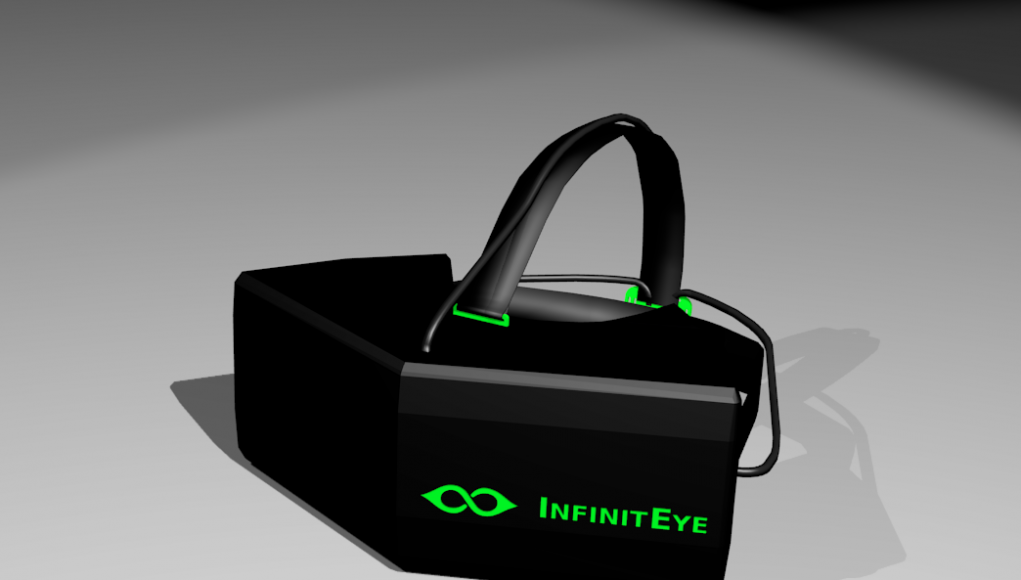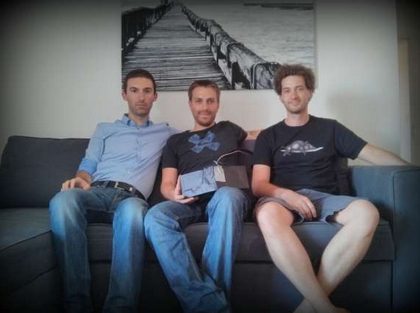 InfinitEye is a head mounted display prototype with a whopping 210 degree horizontal field of view that’s on a similar trajectory as the Oculus Rift; the prototype was conceived and constructed by a group of VR enthusiasts who are looking to bring it to production. The team is competing for €100,000 in funding and guidance to make their prototype a reality — your vote is all it takes!
InfinitEye is a head mounted display prototype with a whopping 210 degree horizontal field of view that’s on a similar trajectory as the Oculus Rift; the prototype was conceived and constructed by a group of VR enthusiasts who are looking to bring it to production. The team is competing for €100,000 in funding and guidance to make their prototype a reality — your vote is all it takes!
Though Palmer Luckey has previously put together 120 degree and 270 degree HMD prototypes, InfinitEye’s achievement is that it could be small and light enough to be worn directly on the head with no additional mounting while still bringing a huge field of view and high resolution to the table.
The current prototype uses two displays to achieve its massive field view. Normally with dual displays you’d need complicated optics to properly align the images with the eyes; InfinitEye is using Fresnel lenses to do so simply and without adding much weight. In fact, the current InfinitEye prototype weighs less than the Oculus Rift (but keep in mind that it is currently made from much less durable material for the sake of rapid prototyping):
There are some concerns with the use of dual displays and Fresnel lenses; chief among them being distortion, clarity, and diagonal alignment. The creators of InftinitEye say that there’s no issue with focus or distortion using the lenses.
With some initial skepticism, VR Enthusiast and MTBS3D user TheLostBrain bought the same lenses used in the prototype to see for himself.
“First things first – I DO stand corrected… I now believe that Fresnels CAN produce a sharp, quality image in an HMD!” he wrote in a post on MTBS3D:
I honestly had my reservations when I ordered these because of the experience I’ve had in the past w/ Fresnel lenses. Generally the ones I’ve worked with offered not much more than a muddy, washed-out view. I’m happy to say these are the exact opposite!
I’d even go as far as to say that when looking through ONE of them at my monitor (positioned ~120mm FL, Fresnel grooves towards the screen)… I can absolutely not tell that I’m looking through a Fresnel vs any other decent quality large acrylic optic. There’s no perception of the Fresnel grooves, etc. at all!
Now, upon adding the second lens things do degrade just a bit. A bit of contrast is lost, a tiny bit of lens smear is detectable on high-contrast scenes, and all of the applicable aberrations are more prevalent. However, much of this is to be expected w/ any type of uncorrected lens assembly.
Also I would like to point out (as Palmer, GeekMaster and others on this thread already have) that Fresnels are are by no means a magic bullet and you will still have to work within the same constraints that apply to standard plano convex lenses. Ex: You still have spherical, chromatic, field curvature, etc. taking shots at your view so you’ll have to do your best to compensate as usual.
With all that said I’m still 100% confident that these lenses do offer some excellent advantages for HMD design where immersive FOV is the primary goal.
- Huge immediate-FOV combined with a very generous eye-relief.
- Full eyeglass compatibility do to that eye-relief.
- Huge reduction in weight vs a comparable system using standard lenses
- Huge reduction in cost vs a comparable system using standard lenses
Palmer Luckey, in a thread on Reddit, notes that “The artifacts of fresnel lenses are not as bad as they used to be, and might look fine on some LCDs, but you can definitely see a significant degradation in quality with high quality/high contrast displays.”
Even so, he remains excited at the prospect of the design and even offered assistance, “It would be very cool if the potential problems are as well solved as you say! We have a lot of optical test gear in the lab, if you want objective distortion/focus measurements, I would be glad to help.”
The dual displays also offer an opportunity to increase resolution over a single-screen head mounted display like the Oculus Rift. While the Rift splits its single 1280×800 display in half, resulting in 640×800 per eye, InfinitEye uses one display per eye — each eye gets the full resolution. Currently the prototype has a resolution of 1280×800 per eye, though this is counterbalanced by being stretched over a field of view almost twice that of the Oculus Rift’s:
The InfinitEye team says they’re aiming for higher resolution panels as development progresses.
There are still challenges to be solved for the InfinitEye design. For one, the team would like to make a custom control board to drive each display in sync, ideally with a single video input. Currently it seems that each display has its own control board and input, adding to weight and complexity. The team would also like to create a custom headtracking solution in place of the current YEI trackers that they’re using.
InfinitEye Competing for €100,000 in Funding and Entrepreneurial Guidance, 4 Days Left to Vote!
 Though the Oculus Rift and InfinitEye both began their journey at MTBS3D, InfinitEye is taking a path other than Kickstarter (for now, perhaps). The team has entered their design into an entrepreneurship contest sponsored by Samsung. The prize is €100,000 in funding to continue the project and also the guidance of an independent entrepreneur who will help make their vision a reality.
Though the Oculus Rift and InfinitEye both began their journey at MTBS3D, InfinitEye is taking a path other than Kickstarter (for now, perhaps). The team has entered their design into an entrepreneurship contest sponsored by Samsung. The prize is €100,000 in funding to continue the project and also the guidance of an independent entrepreneur who will help make their vision a reality.
You can help InfinitEye secure their funding and entrepreneurial support simply by voting for their project in the contest. The contest is in French, but the InfinitEye team says that international votes are welcome.
Vote for InftinitEye in the Funding Contest
Here’s how to vote:



4. Give the app permission to cast your vote. Don’t worry about the dialogue box that pops up at the end asking for an email address, that’s for a raffle.
My vote is cast!
The InfinitEye Team
I spoke with InfinitEye design Lionel Anton to learn more about the team working on this exciting HMD. Here’s his breakdown:
Lionel Anton, 30 years old. I’m a software engineer specialized in image processing but since always I’ve been tinkering with various hardware projects. I guess the thing that got me into VR is when I started a DIY projector back in 2006, I bought an old projector in which I found an aspheric lens for light collimation and seeing how close I could make focus on objects, I immediately thought about making a 3D display with a screen near my face and two of these lenses, a wide FOV 3D HMD. But at that time, I had other projects and this was only an idea in my mind. Then in winter 2010 I finally got the time to re-think about this and I made a post on MTBS3D in august 2011 to present the concept (http://www.mtbs3d.com/phpBB/viewtopic.php?f=26&t=13659, it was the first project there that was using one screen with 2 lenses). Then I let it into oblivion until last year when I saw how successful the Rift campaign was and how much people were interested in VR. I knew that I could design something with a much wider field of view, and I started to work on a dual screen concept. I made a thread on MTBS3D in February to show the project and since then I’ve continued to improve the design.
Stephane Portes, 30 years old. He’s a friend I’ve known for 17 years. He’s the one who saw the potential of the concept and pushed me to make something with it. Also, he’s passionate about IT technologies and Virtual Realities. He has a strong technical background in IT and works as an international IS project manager for a famous aircraft manufacturing company on behalf of an IT Services company. Therefore he’s very skilled in management, marketing and communication an joined the project to take care of all these aspects, including the participation to the Samsung contest.
Robin Bourianes, 30 years old. I’ve known Robin for 13 years, we share the same education at the University of Toulouse in AI, robotics, VR (mainly 3D programming), image processing and computer science engineering. He’s a talented 3D expert, software architect and engineer and he joined the team a few months ago as the main developer. He developed the 3D engine and all the specialized warping stuff we used for the demo in which he integrated the Oculus VR Tuscany environment.
We’ll be continuing to watch the InfinitEye project closely — best of luck to these three!










